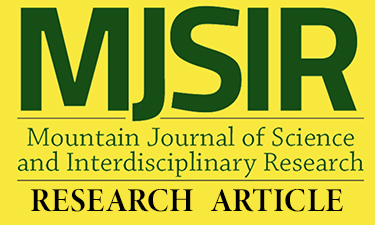Nutritional and Blood Pressure Profile and Its Correlates: The Case of Benguet State University Employees, Philippines
Main Article Content
Abstract
Experts have identified the increasing trend of overnutrition and are recommending the implementation of an appropriate nutrition action plan based on sound and extensive research data. In support of this, the study evaluated the nutritional status and blood pressure of employees in Benguet State University vis-a-vis their work performance ratings, as part of developing a nutritional plan for the agency. Body Mass Index (BMI), waist circumference (WC) and waist-hip ratio (WHR) were used as indicators of the nutritional status. A self-administered questionnaire was used to gather the socioeconomic profile of the 116 randomly selected employees. The majority were in their peak of productive years, females, non-teaching, college graduates, co-breadwinners, have served for >10 years, and are of outstanding work performance based on the University’s performance evaluation instrument. The analysis revealed that half of the employees had normal body mass indices, the rest being overweight (42%), and obese (8%). Mean waist circumference and waist-hip ratio, however, did not indicate abdominal adiposity. Only one-fifth (20%) had blood pressure readings within the normal range despite the use of medications. Education, religion, and family income were correlated with BMI. Sex and household size were associated with WHR while sex and family income correlate with high blood pressure. Work performance rating, on the other hand, did not correlate significantly with the nutritional status of the employees. The study hopes that these data will help guide the crafting of a holistic wellness program of the University to avert overweight, obesity, and high blood pressure.
Article Details
References
Anderson, J.B., Root, M.M., & Garner, S.C. (2015). Human Nutrition: Healthy Options for Life. MA: Jones & Bartlett Learning.
Baccay, O.T. (2018). DILG to LGU: Implement nutrition action plan. Philippine Information Agency. Retrieved from https://pia.gov.ph/news/ articles/1009201
Bellosillo, A.B. (n.d.). Facts and Information on Coronary Heart Disease and Fibre. Makati City: FLEHD.
Brown, C.B., Higgins, M., Donato, K.A., Rohde, F.C., Garrison, R., Obarzanek, E., Erst, N., & Horan, M. (2000). Body mass index and the prevalence of hypertension and dyslipidemia. Obesity Research. 8(9): 605-19.
Bustillos, A.S., Vargas, K.G. III, & Cuadra, R.G (2015). Journal of Epidemiology and Global Health, 5:191-199.
Center for Disease Control and Prevention (CDC). (n.d.). Healthy Weight: About Adult BMI. Retrieved at www.cdc.gov/healthyweight/assessing/bmi/adult_bmi/ on April 24, 2017.
Claudio, V., & Ruiz, A. (2010). Nutrition Education: Principles, Approaches and Strategies. Merriam and Webster Bookstore, Inc. Metro, Manila, Philippines.
Degay, I.O. (2008). Nutritional Status of Benguet State University Employees and Students. BSU College of Home Economics and Technology Research Journal, 5:22-39
De la Paz, C.R. (n.d). Screening for Overweight and Obesity in Adults. In: State of the Art of Obesity Research in the Philippines, 1998-2011. Pasay City.
Dellova, C.V., Roxas, M.G.R., Velasco, Z.F., & Pataunia, Ma.C.A. et (2006). ABC’s of Nutrition and Diet Therapy. Mutya Publishing Home. Metro Manila, Philippines. Retrieved from http://mutyapublishing.com.ph/?product=abcs-of-nutrition-and-diet-therapy-for-nursing- students-and-healthcare-practitioners
Drevvoid, W.B., Midtheill, K., Nilsen, T.I., & Holmen, J. (2005). Change in body mass index and its impact on blood pressure: a prospective population study. Int J Obes. 29(6): 650-5.
Dyer, A.R., & Elliott, P. (1989). The INTERSALT study: relations of body mass index to blood pressure. Journal of Human Hypertension 3(5): 299-308.
Ellen, S. (2018). Slovin's Formula Sampling Techniques. Retrieved at https://sciencing.com/slovins-formula-sampling-techniques-5475547.html
Eppright, E. (1963). Teaching Nutrition. 2nd Ed. Iowa State Press, Ames, Iowa
FNRI-DOST. (2015). 8th National Nutrition Survey. Taguig City: FNRI
FNRI-DOST. (2016). 2015 Updating of the Nutritional Status of Filipino Children and Other Population Groups. Handbook focus on the Cordillera Autonomous Region distributed during the Regional Dissemination Forum on September 8, 2016 at Eurotel, Baguio City
Galicia, M.V.H., Arkoncel, M.L.C., & Pacheco, E.P., (2018). Complications of Adult Obesity. In: State of the Art of Obesity Research in the Philippines, 1998-2011. Pasay City
Gasperin, D., Gopal, N., Dias-da-Costal, Juvenal Soares, J.S., & Pattussi, M.P. (2009). Effect of Psychological Stress on BP Increase: A Meta- Analysis of Cohort Studies. Available at www.scielo.br/pdf/csp/v25N4/02.pdf.
Gjonca, E. & Calderwood, L. (2004). Socio-Demographic Characteristics. Institute for Fiscal Studies. Accessed on April 24, 2017
Martins, V.J.B., Toledo-Florêncio, T.M., Grillo, L.P., Franco, M.C.P., Martins, P.A., Clemente, A.P.G., Santos, C.D.L., Vieira, M.F.A., & Sawaya, A.L. (2011). Long-lasting effects of under nutrition. Int J Environ Res Public Health, 8(6):1817–1846. doi: 10.3390/ijerph8061817.
Mozaffarian, D., Angell, S.Y., Lang, T., & Rivera, J.A. (2018). Roles of government policy in nutrition-barriers to and opportunities for healthier eating. BMJ, 361:k2426.
Mungreiphy, N.K., Kapoor, S., & Sinha, R. (2011). Association between BMI, Blood pressure and age: study among Tangkul Naga Tribal Males of Northeast India. Journal of Anthropology. National Nutrition Council. Nutrition Month Talking Points. (2015). Makati City
NDAP. (n.d.). Hypertension. Available at http://www.ndap.org.ph/hypertension-0. Accessed on February 7, 2016
Noble, R.E. (2001). Waist-to-hip ratio versus BMI as predictors of cardiac risk in obese adult women. Western Journal of Medicine, 174 (4): 240-241
Philippine Statistic Authority. (2012). Family and Income Expenditures Survey. Retrieved at www.psa.gov.ph/statistics

